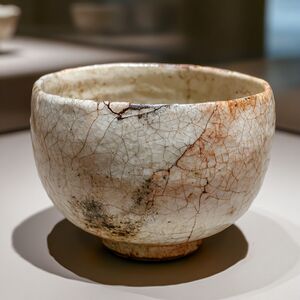Muji Shino

Muji Shino is a subtype of Shino ware originating in the Mino Province kilns (present-day Gifu Prefecture). It is characterized by its plain white glaze without painted decoration, emphasizing the natural qualities of the clay and glaze.
History
Muji Shino developed in the late Momoyama period (late 16th century) alongside other Shino ware variations. While many Shino pieces featured brush-painted iron-oxide motifs, Muji Shino rejected decoration in favor of a minimal, unembellished appearance. This simplicity resonated with the aesthetics of the Japanese tea ceremony.
Characteristics
Muji Shino is known for:
- Thick white feldspar glaze (志野釉, Shino-yū), producing a creamy or slightly pinkish surface.
- Absence of painted decoration, creating a minimalist aesthetic.
- Subtle surface texture from the clay body.
- Soft color variations caused by uneven kiln atmosphere during firing.
Cultural significance
The restrained elegance of Muji Shino reflects the wabi-sabi principles of simplicity and imperfection. Its plain surface draws attention to form, glaze texture, and the tactile qualities of the ceramic.
Modern production
Contemporary Muji Shino is still produced in Gifu Prefecture, often as tea bowls, cups, and plates. Modern potters may experiment with glaze thickness and firing conditions to achieve varied white tones.
See also
External links
- Tajimi Tourism Association (in Japanese)